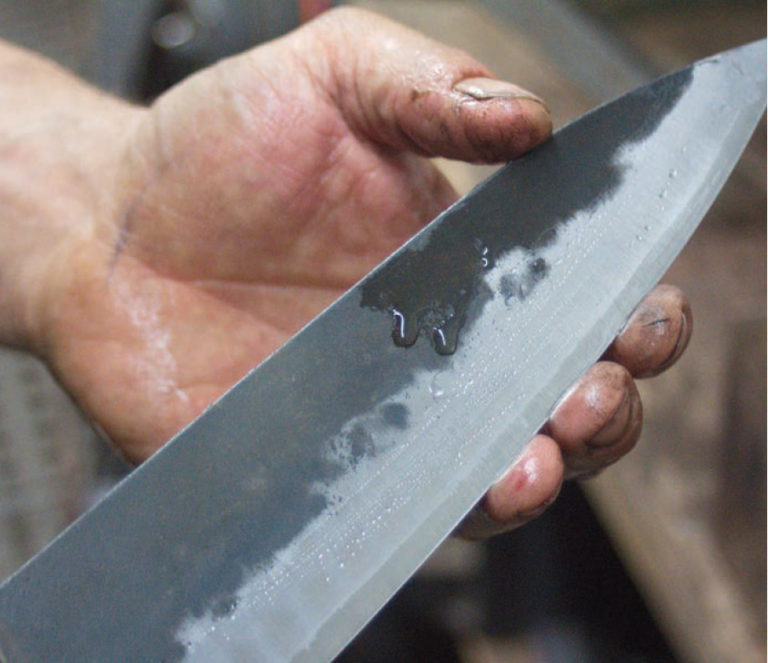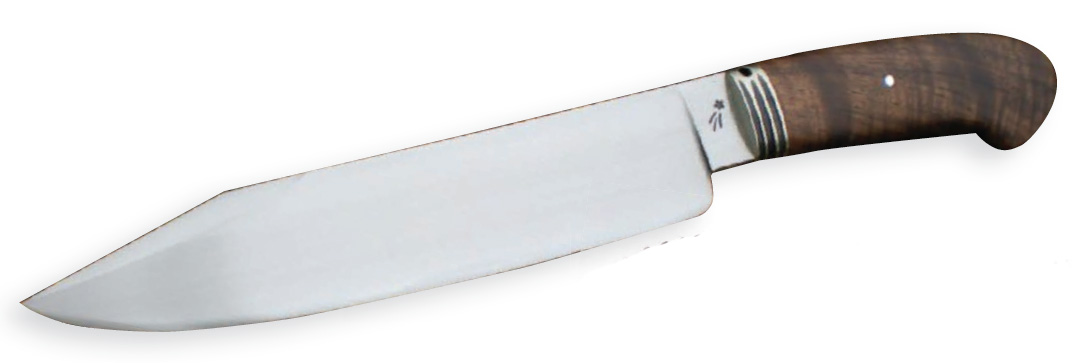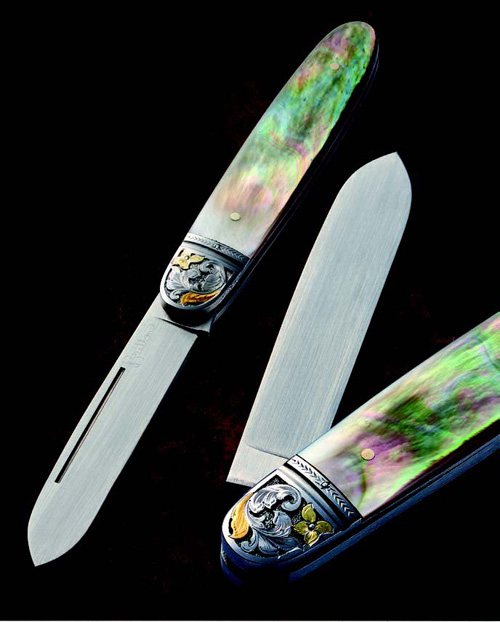
It’s easy to use steel type as shorthand for quality, but that’s only one factor when it comes to the performance of a knife. Heat treating, Rockwell hardness and geometry also matter.
Sure, it’s all about the steel. Blade steel makes the knife world go ’round, right? Well, further analysis just might reveal a few additional elements that weigh in on the sharpness of a knife blade, and custom knifemakers already account for these factors when they complete their stock in trade.
In Search of “True Sharpness”
Considering heat treat, edge geometry, handle ergonomics, Rockwell hardness and other contributors, the comprehensive analysis of “true sharpness” is an eye-opening experience.
“Assume that all knives are sharp when you get them,” said maker Jerry Hossom. “The question is more about what you want to cut, and is the edge geometry and finish one that will do the work you want done. For example, a sharp but coarse edge will not hold up well with hard blade materials.”
Frankly, the ingredients are intertwined, and the path to true sharpness makes frequent stops along the way.
Experience in making and cutting with various materials and knife designs brings knowledge of the process and the expected results.
Physical Features

“I can and will only speak from personal experience,” commented ABS master smith Jim Crowell, winner of numerous cutting competitions through the years, including the first ABS/BLADE Show World Championship Cutting Competition in 2003. “Since it would be difficult if not impossible to tell by looking, I would consider the reputation of the maker and his or her history.
“Not knowing who made the knife, I would consider the following: Visualize the geometry and edge treatment. The intangible here is the heat treat. If I’m looking at a knife I know nothing about, the physical features that herald sharpness and performance are blade grind/geometry and the edge. If the blade is ground from the spine to the cutting edge, it achieves the smoothest transition from ‘zero’ at the cutting edge to the full thickness of the spine.
“In my opinion, a flat-ground blade with a convex edge is the best geometry. This is the smoothest transition from cutting edge to spine irrespective of spine thickness or width.”
Steel Type & Blade Performance

Of course, a quick nod to the steel has to figure in. Without the steel itself, nothing else matters.
“How often have I heard that a knife holds an edge very well but is too difficult to sharpen?” Hossom offered. “They are opposite sides of the same coin. Wear resistance in cutting is the same attribute as wear resistance in sharpening, and again, it depends on the intended use.”
Discussion also surrounds standard versus premium steels, given that either is properly prepared.
“So-called standard steels have their place, but I’m not sure where,” explained maker Tim Britton. “I started with O1 in 1972 and Blackie Collins talked me into using 440C. Peer pressure… Ted Dowell, Frank Centofante, Jimmy Lile and Bob Dozier had settled on D2. New stuff like S35VN leaves them all in the dust. It takes twice as many belts to grind the blade and is max stain resistant. I’ve had great field reports from guides who dress a lot of deer, and one who is a pest control hunter and kills a lot of hogs and nutria.”
According to Crowell, everyone probably agrees that quality steel is a must.
“Some steels lend themselves to cutlery more so than others,” he reasoned. “There are some ‘exotic’ steels that truly outperform, but they are usually more expensive and harder to work with. Then, there are inexpensive steels used in cheap manufactured knives sold in bargain stores.”
Crowell looks at the long-time rub between carbon and stainless steels and likes the “10” series spring steels, 5160, O1, W2 and L6, among others. He prefers steels with 75 percentage points of carbon or more, though 5160 with 60 points of carbon is workable as well.
Rockwell Hardness
For some makers, Rockwell hardness sets the bar in potential sharpness for knife blades. Other factors are important but the scale tells the tale.
“Rockwell hardness has a huge influence on how sharp you can get a knife and how it will hold an edge,” asserted maker Murray Carter. “There may be a rebuttal out there, but I believe it is a universal truth. If hardness is related to how sharp you can get the blade and how it will hold an edge, the element of carbon is responsible for the hardness you can achieve.”
Hardness is forever linked to heat treating. Blades that are not heat treated properly just won’t stay sharp—and they are likely to fail in other performance metrics as well. Game over!
Heat Treating

high-performance CPM 3V carbon steel. (Eric Eggly/PointSeven image)
Proclaimed Britton, “Heat treating is critically important for any steel.”
Added Hossom, “Unless it is heat treated properly, a steel is an undefined mass of metal with uncertain performance qualities. In fairness, it should not even be labeled as a specific type of steel because such a label implies proper heat treatment. I have my blades professionally heat treated by Paul Bos Heat Treating because I simply can’t do it as well as he can, especially with high alloy, high performance grades of steel.”
Carter echoed that sentiment.
“Heat treating is so important,” he emphasized. “All our blades are quenched in water, while some quench theirs in oil. Others are just air hardened. Water quenching is severe, an extreme form, and the only one harder is brine quenching.”
Geometry
Crowell ups the ante with the bold statement, “My strong opinion is that heat treat and geometry are more important to the performance of a knife than the specific type of steel. The best steel in the world would not fare well if the heat treat was bad and the geometry poor.”
Stressing edge geometry, Crowell further advises, “Edge geometry is particularly important. If a maker tests his work and is confident about the heat treat but the knife is not cutting well, the edge can be adjusted or ‘rolled’ to a different shape.”
What Factor is the Most Important?
So perhaps the most important takeaway from a discussion on sharpness is the advice the pros give to prospective buyers. Assessing the sharpness and relative quality of the future cutting experience involves a discerning eye and some attention to detail. What advice do custom knifemakers over the buying public?
“I would start by looking at the knife and seeing if the geometry looked good and how well made the knife appeared to be,” Crowell advised. “That would show the maker was paying attention to detail and would be a positive sign to me. I would ask what kind of steel was used and how it was heat treated, and by whom. There are several very good heat treaters out there. If the maker did the heat treat, I would ask how—oven, forge, kiln, torch? I would want to know if the maker tests his work and if he has chopped, whittled, and cut stuff.”
The inquiry is basic, Britton says, and the maker should be forthcoming with reasonable responses.
“Buying a knife from a reputable maker should be simple,” he noted. “My questions would be steel type, Rockwell hardness, and what kinds of tools the maker has in his shop. I’m a dinosaur. I won’t buy a production knife that was made by machines in batches of 20 or 30. I’m a proud member of the ABS and don’t know any steel beaters who mass produce any design.”
The sharpness of a knife blade goes well beyond the steel. The combination of steel, hardness, heat treat, edge geometry and handle ergonomics feeds the finished product. However, these are only as supportive of the knife’s function as the skill set of the maker’s hand in action.
 NEXT STEP: Download Your Free KNIFE GUIDE Issue of BLADE Magazine
NEXT STEP: Download Your Free KNIFE GUIDE Issue of BLADE Magazine
BLADE’s annual Knife Guide Issue features the newest knives and sharpeners, plus knife and axe reviews, knife sheaths, kit knives and a Knife Industry Directory.Get your FREE digital PDF instant download of the annual Knife Guide. No, really! We will email it to you right now when you subscribe to the BLADE email newsletter.







Oh, yeah! This is exactly what my son needs because he’s been gathering some essential tools for his upcoming camping trip with his friends next month. I’ll make sure he includes this option into consideration when making a purchase later. Your detailed explanation on how sturdy and long-lasting a steel blade is was really helpful. https://georgiaproflooring.com/product/787-carbide-tipped-steel-blade/